CADILLAC CTS 2004 1.G Owners Manual
Manufacturer: CADILLAC, Model Year: 2004, Model line: CTS, Model: CADILLAC CTS 2004 1.GPages: 454, PDF Size: 2.87 MB
Page 171 of 454

Security Light
For information
regarding this light,
seeTheft-Deterrent
System on page 2-18.
Fog Lamp Light
This light will come on
when the fog lamps
are in use.
The light will go out when the fog lamps are turned off.
See “Fog Lamps” underTurn Signal/Multifunction
Lever on page 3-10for more information.
Lights On Reminder
This light comes on whenever the parking lamps are on.
See “Headlamps On Reminder” underTurn Signal/
Multifunction Lever on page 3-10for more information.
CTSCTS-V
3-51
Page 172 of 454
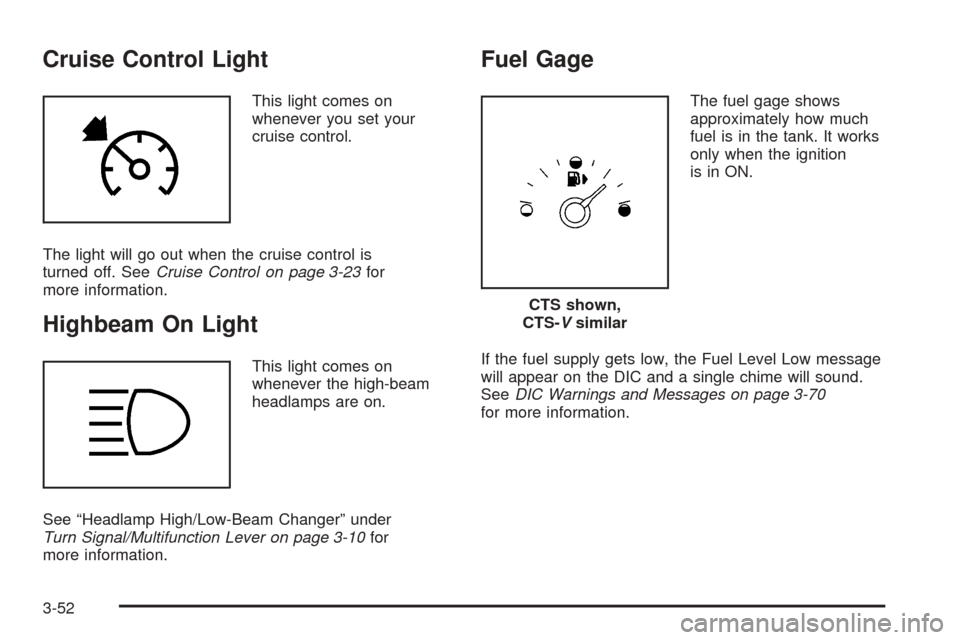
Cruise Control Light
This light comes on
whenever you set your
cruise control.
The light will go out when the cruise control is
turned off. SeeCruise Control on page 3-23for
more information.
Highbeam On Light
This light comes on
whenever the high-beam
headlamps are on.
See “Headlamp High/Low-Beam Changer” under
Turn Signal/Multifunction Lever on page 3-10for
more information.
Fuel Gage
The fuel gage shows
approximately how much
fuel is in the tank. It works
only when the ignition
is in ON.
If the fuel supply gets low, the Fuel Level Low message
will appear on the DIC and a single chime will sound.
SeeDIC Warnings and Messages on page 3-70
for more information.
CTS shown,
CTS-Vsimilar
3-52
Page 173 of 454
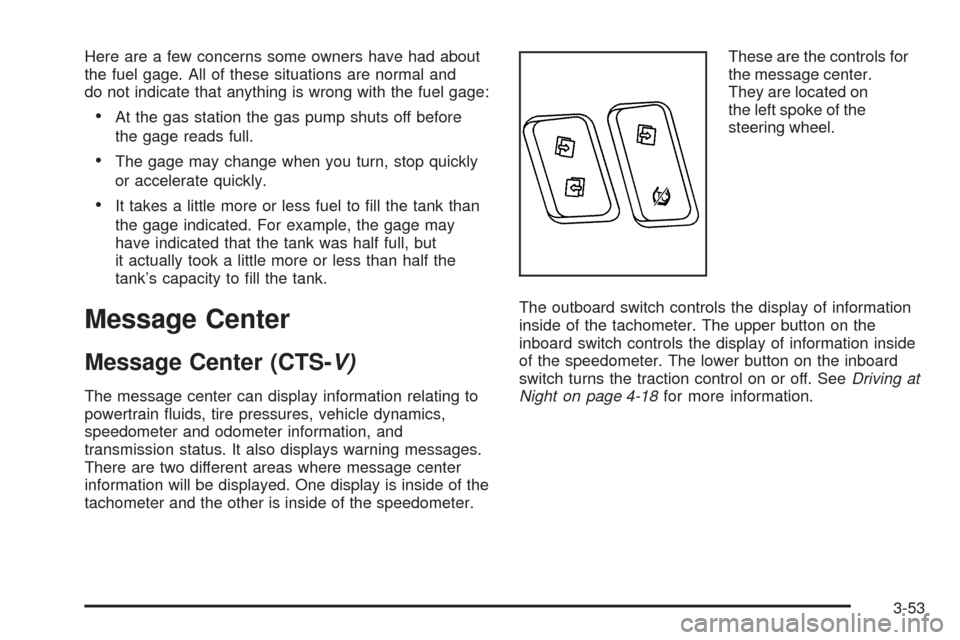
Here are a few concerns some owners have had about
the fuel gage. All of these situations are normal and
do not indicate that anything is wrong with the fuel gage:
At the gas station the gas pump shuts off before
the gage reads full.
The gage may change when you turn, stop quickly
or accelerate quickly.
It takes a little more or less fuel to �ll the tank than
the gage indicated. For example, the gage may
have indicated that the tank was half full, but
it actually took a little more or less than half the
tank’s capacity to �ll the tank.
Message Center
Message Center (CTS-V)
The message center can display information relating to
powertrain �uids, tire pressures, vehicle dynamics,
speedometer and odometer information, and
transmission status. It also displays warning messages.
There are two different areas where message center
information will be displayed. One display is inside of the
tachometer and the other is inside of the speedometer.These are the controls for
the message center.
They are located on
the left spoke of the
steering wheel.
The outboard switch controls the display of information
inside of the tachometer. The upper button on the
inboard switch controls the display of information inside
of the speedometer. The lower button on the inboard
switch turns the traction control on or off. SeeDriving at
Night on page 4-18for more information.
3-53
Page 174 of 454
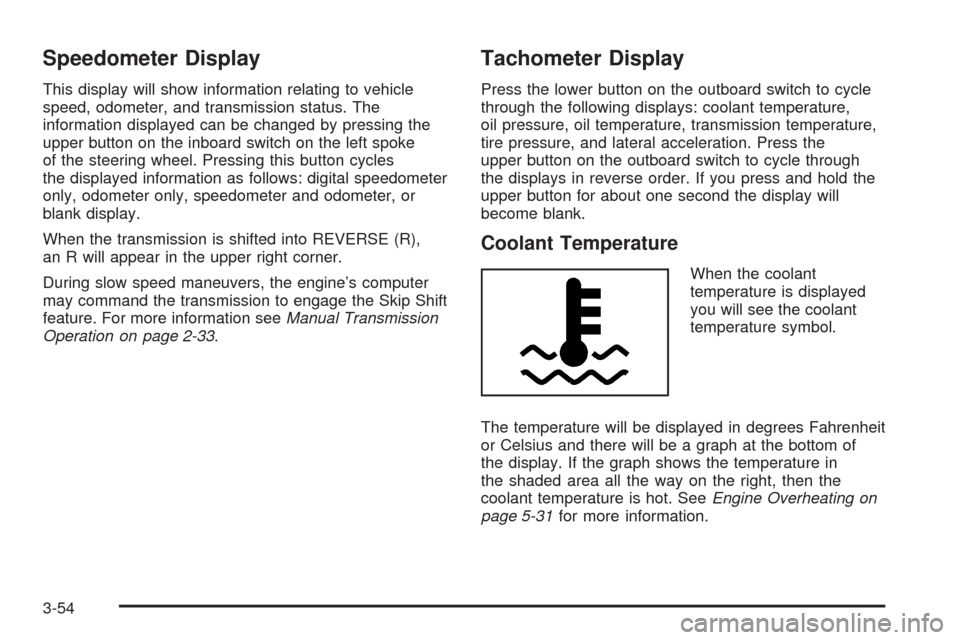
Speedometer Display
This display will show information relating to vehicle
speed, odometer, and transmission status. The
information displayed can be changed by pressing the
upper button on the inboard switch on the left spoke
of the steering wheel. Pressing this button cycles
the displayed information as follows: digital speedometer
only, odometer only, speedometer and odometer, or
blank display.
When the transmission is shifted into REVERSE (R),
an R will appear in the upper right corner.
During slow speed maneuvers, the engine’s computer
may command the transmission to engage the Skip Shift
feature. For more information seeManual Transmission
Operation on page 2-33.
Tachometer Display
Press the lower button on the outboard switch to cycle
through the following displays: coolant temperature,
oil pressure, oil temperature, transmission temperature,
tire pressure, and lateral acceleration. Press the
upper button on the outboard switch to cycle through
the displays in reverse order. If you press and hold the
upper button for about one second the display will
become blank.
Coolant Temperature
When the coolant
temperature is displayed
you will see the coolant
temperature symbol.
The temperature will be displayed in degrees Fahrenheit
or Celsius and there will be a graph at the bottom of
the display. If the graph shows the temperature in
the shaded area all the way on the right, then the
coolant temperature is hot. SeeEngine Overheating on
page 5-31for more information.
3-54
Page 175 of 454
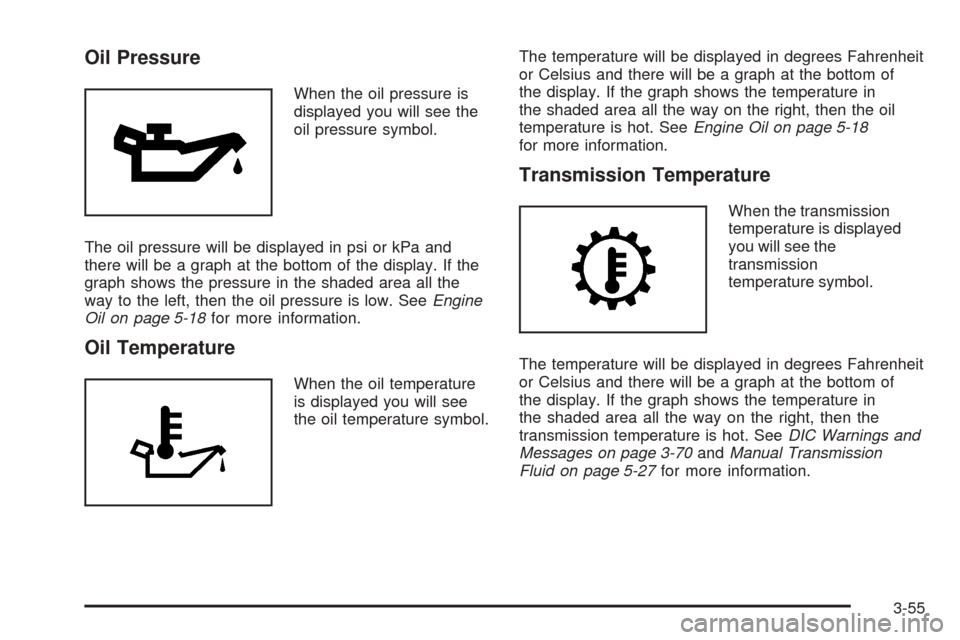
Oil Pressure
When the oil pressure is
displayed you will see the
oil pressure symbol.
The oil pressure will be displayed in psi or kPa and
there will be a graph at the bottom of the display. If the
graph shows the pressure in the shaded area all the
way to the left, then the oil pressure is low. SeeEngine
Oil on page 5-18for more information.
Oil Temperature
When the oil temperature
is displayed you will see
the oil temperature symbol.The temperature will be displayed in degrees Fahrenheit
or Celsius and there will be a graph at the bottom of
the display. If the graph shows the temperature in
the shaded area all the way on the right, then the oil
temperature is hot. SeeEngine Oil on page 5-18
for more information.
Transmission Temperature
When the transmission
temperature is displayed
you will see the
transmission
temperature symbol.
The temperature will be displayed in degrees Fahrenheit
or Celsius and there will be a graph at the bottom of
the display. If the graph shows the temperature in
the shaded area all the way on the right, then the
transmission temperature is hot. SeeDIC Warnings and
Messages on page 3-70andManual Transmission
Fluid on page 5-27for more information.
3-55
Page 176 of 454

Tire Pressure
When the tire pressure is displayed you will see a
vehicle in the display. The numbers in each corner
represent the tire pressure for the corresponding tire.
The tire pressure will be displayed in psi or kPa.
If any of the tires are blinking on the vehicle in the
display, this means that the tire pressure in that tire is
either high or low. SeeTire Pressure Monitor System
(CTS-V) on page 5-70for more information.
Lateral Acceleration
Lateral acceleration is a measure of how hard you are
taking a corner. For example, when you are turning right
you will feel your body push to the left. This force is
measured in a “g”. This gage will display from 0.00 g to
1.2 g. The lowest reading means there is no lateral
acceleration. The highest reading means the force the
driver is feeling is 1.2 times the acceleration due
to gravity.
When the lower button on the outboard switch is
pressed and held while the Lateral Acceleration display
is being shown, the peak hold values—both tick
marks and numbers—will be reset to zero.
Warning Messages
The warning messages that are described in the
following text are also shown in the tachometer display.
While any warning messages are shown, pressing
either button on the outboard switch will acknowledge
the warning and then display the gage relating to
the error message. For instance, if a tire is below the
minimum recommended pressure, the tire pressure
warning message will blink on and off (5 times for a
low tire warning, continuously for a �at tire warning).
The driver can go to the tire pressure display
immediately by pressing either button on the
outboard switch.
3-56
Page 177 of 454
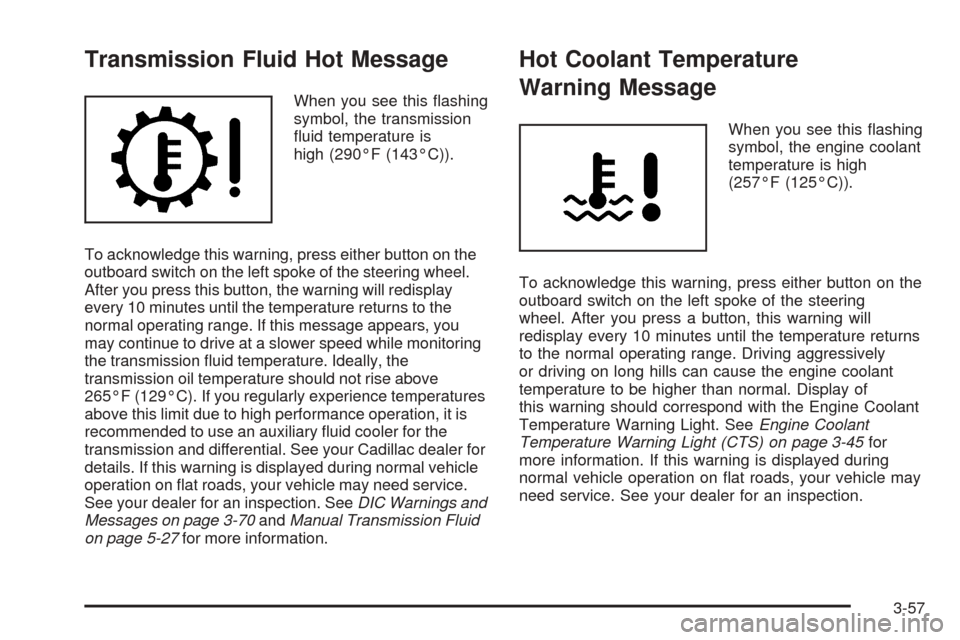
Transmission Fluid Hot Message
When you see this �ashing
symbol, the transmission
�uid temperature is
high (290°F (143°C)).
To acknowledge this warning, press either button on the
outboard switch on the left spoke of the steering wheel.
After you press this button, the warning will redisplay
every 10 minutes until the temperature returns to the
normal operating range. If this message appears, you
may continue to drive at a slower speed while monitoring
the transmission �uid temperature. Ideally, the
transmission oil temperature should not rise above
265°F (129°C). If you regularly experience temperatures
above this limit due to high performance operation, it is
recommended to use an auxiliary �uid cooler for the
transmission and differential. See your Cadillac dealer for
details. If this warning is displayed during normal vehicle
operation on �at roads, your vehicle may need service.
See your dealer for an inspection. SeeDIC Warnings and
Messages on page 3-70andManual Transmission Fluid
on page 5-27for more information.
Hot Coolant Temperature
Warning Message
When you see this �ashing
symbol, the engine coolant
temperature is high
(257°F (125°C)).
To acknowledge this warning, press either button on the
outboard switch on the left spoke of the steering
wheel. After you press a button, this warning will
redisplay every 10 minutes until the temperature returns
to the normal operating range. Driving aggressively
or driving on long hills can cause the engine coolant
temperature to be higher than normal. Display of
this warning should correspond with the Engine Coolant
Temperature Warning Light. SeeEngine Coolant
Temperature Warning Light (CTS) on page 3-45for
more information. If this warning is displayed during
normal vehicle operation on �at roads, your vehicle may
need service. See your dealer for an inspection.
3-57
Page 178 of 454
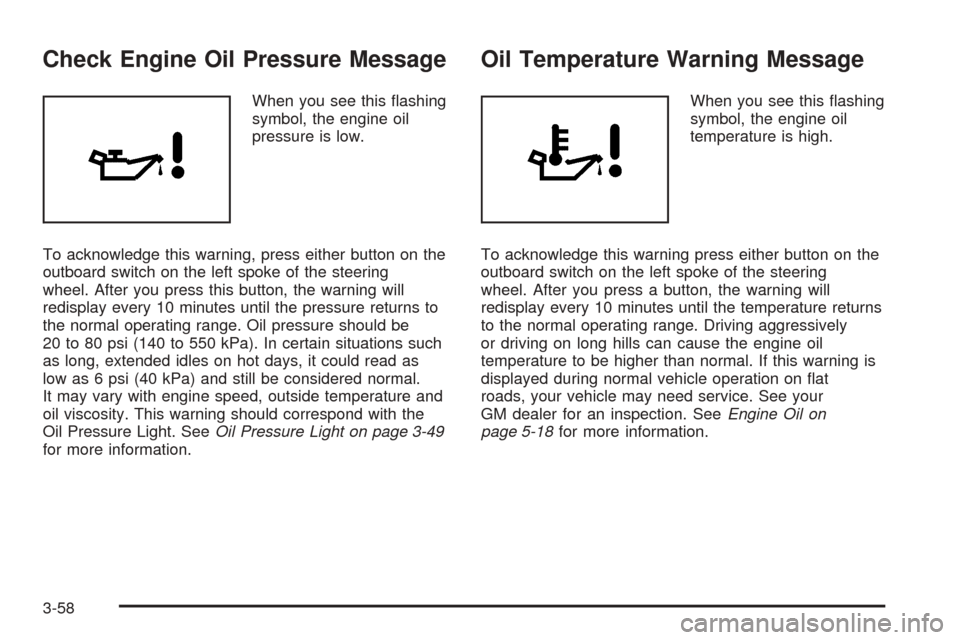
Check Engine Oil Pressure Message
When you see this �ashing
symbol, the engine oil
pressure is low.
To acknowledge this warning, press either button on the
outboard switch on the left spoke of the steering
wheel. After you press this button, the warning will
redisplay every 10 minutes until the pressure returns to
the normal operating range. Oil pressure should be
20 to 80 psi (140 to 550 kPa). In certain situations such
as long, extended idles on hot days, it could read as
low as 6 psi (40 kPa) and still be considered normal.
It may vary with engine speed, outside temperature and
oil viscosity. This warning should correspond with the
Oil Pressure Light. SeeOil Pressure Light on page 3-49
for more information.
Oil Temperature Warning Message
When you see this �ashing
symbol, the engine oil
temperature is high.
To acknowledge this warning press either button on the
outboard switch on the left spoke of the steering
wheel. After you press a button, the warning will
redisplay every 10 minutes until the temperature returns
to the normal operating range. Driving aggressively
or driving on long hills can cause the engine oil
temperature to be higher than normal. If this warning is
displayed during normal vehicle operation on �at
roads, your vehicle may need service. See your
GM dealer for an inspection. SeeEngine Oil on
page 5-18for more information.
3-58
Page 179 of 454

Tire Pressure Warning Message
When you see this �ashing
symbol, one or more of the
vehicle’s tires is either
under or over-in�ated.
To acknowledge this warning, press either button on the
outboard switch on the left spoke of the steering
wheel. There are three levels of warning for this display:
1. High Tire Pressure (above 42 psi (290 kPa))
2. Low Tire Pressure (below 25 psi (170 kPa))
3. Flat Tire (below 5 psi (35 kPa))For conditions 1 and 2, this warning will �ash �ve times
and the display will then show the tire pressure gage.
For condition 3, this warning will �ash continuously until
the driver acknowledges it. In any of the three cases,
the warning will redisplay every 10 minutes until
the situation is corrected. Conditions 2 and 3 will also
display a warning light elsewhere on the cluster that will
stay illuminated after this warning is acknowledged.
SeeTire Pressure Light (CTS-V) on page 3-46for more
information. Also seeTire Pressure Monitor System
(CTS-V) on page 5-70for more information on tire
pressure speci�cations.
3-59
Page 180 of 454

Driver Information Center (DIC)
The DIC gives you the status of many of your vehicle’s
systems. It is also used to display driver personalization
features and warning/status messages. All messages
will appear on the audio system display which is also the
display for the Navigation system.
System Controls
If you have the Base audio system, use the following to
operate the DIC:
INFO (Information):Use the up or down arrows on this
switch to scroll through the system status information.
CLR (Clear):Press this button to clear DIC messages
and to reset DIC items to zero. This button is also
used to exit out of a menu. SeeDIC Warnings and
Messages on page 3-70andStatus of Vehicle Systems
on page 3-61for more information.
TUNE/SEL (Select) Knob:Once a menu is displayed,
use the knob located to the lower right of the display to
scroll through the menu items and/or select them.
To scroll through the menu items, turn the knob. Once
an item is highlighted, press the knob once to select it.
Base Audio System
3-60